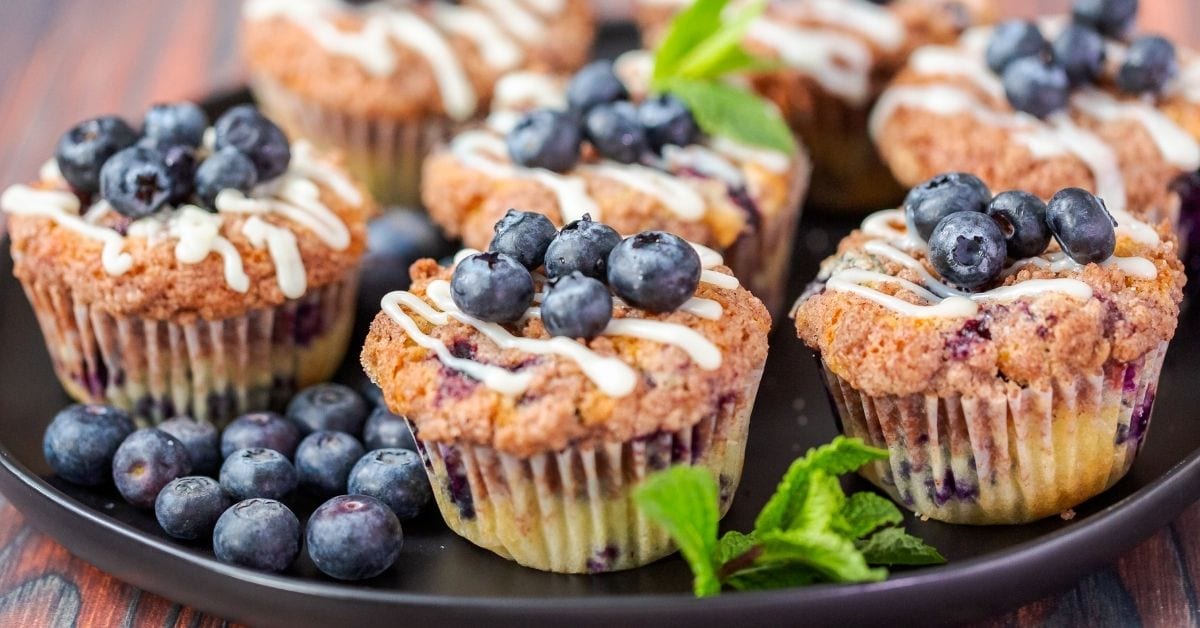Thanks to these blueberry muffins with frozen blueberries, you can have a sweet, easy breakfast on the go any time of year.
Because when it comes to muffins, blueberry is King.

There are plenty of breakfast muffins out there I love, But blueberry is just the right amount of sweet, tart, and fruity.
The only problem is, fresh blueberries are only available for such a short window of time.
Luckily, there’s no need to feel blue because frozen blueberries are here to save the day.
And these aren’t just any blueberry muffins with frozen blueberries, either! They have the most scrummy crumb top I know you’ll love.
Blueberry Muffins With Frozen Blueberries
These blueberry muffins are the epitome of baked goods.
They’re soft and cakey, not dense and heavy. And every bite is bursting with sweet and juicy blueberries.
Plus, the sweet, crumbly, and buttery cinnamon streusel on top makes them to die for!
Whether you make big, bakery-style muffins or adorable mini-muffins, you can’t go wrong.
No matter the size, these muffins are absolute perfection.
Can Frozen Blueberries Be Used in Muffins?
Nothing beats the goodness of fresh blueberries, but when you’re craving these muffins in winter, what are you to do?
Frozen blueberries are your best option to enjoy these ridiculously delicious muffins without having to wait for summer.
Most people hate the fact that frozen blueberries tend to bleed into the batter, resulting in purple-green muffins.
But don’t worry, I’ll give you all the tips and tricks I have up my sleeve to make sure this doesn’t happen.
Ingredients
- Blueberries – Fresh is always best, except when fresh isn’t in season. Using frozen blueberries will allow you to make these muffins any day of the year.
- All-purpose Flour – The base ingredient found in all baked goods.
- Granulated Sugar – For sweetness.
- Salt – To contrast the sugar.
- Baking Powder – The leavening agent that will make the batter rise into tall, fluffy muffins.
- Vegetable Oil – While many recipes call for butter, I like using oil for maximum muffin moistness.
- Egg – It binds the ingredients and helps the batter rise as well.
- Milk – All batter recipes require a liquid ingredient to saturate the dry ingredients. Milk is awesome because it adds richness.
- Crumble Topping – A buttery, crumbly, streusel topping made of sugar, flour, butter, and cinnamon
How Do You Keep Frozen Blueberries From Sinking in Muffins?
Don’t you just hate it when this happens?
I experienced this mishap the first time I ever baked blueberry muffins, and I vowed to find a way for it to never happen again.
It turns out, the secret is simple! Just toss the dry frozen blueberries in 1 to 2 tablespoons of flour, and there you go, problem solved.
With this technique, you’ll get bursts of blueberries in every bite.
Should You Rinse Frozen Blueberries Before Baking?
It really is a matter of preference. If you don’t want bleeding muffins, then yes, you absolutely should rinse frozen blueberries before baking.
However, be aware that rinsing them will also lose some of the berries’ flavor and nutrition.
Just a little bit, though, because the majority of its juices still remain inside the berries.
That said, if you don’t mind purplish-green muffins, by all means, don’t rinse.
If you want prettier muffins, wash your berries with cold water. You’ll want to do this several times until the water becomes lighter in color.
The water will be super dark blue during the first few rounds, but it’ll eventually become significantly lighter.
Dry the berries with paper towels, careful not to pop them.
With this rinse and dry method, you will still see a few streaks of blue in the batter here and there, but at least it won’t turn it completely blue.

Tips for the Best Muffins
- Use room temperature ingredients, particularly the egg and the milk. Cold dairy won’t mix well with other ingredients. If you forget to take the egg out of the fridge, just run it under hot water for a few minutes.
- For the crumble topping, use softened butter. Take it out of the fridge around 20 minutes before cutting. If you forget, just microwave it on low power for 10 seconds.
- Measure the flour accurately. Excessive flour will result in tough and dry muffins.
Use a kitchen scale if you have one – 1/3 cup flour is equivalent to 45 grams or 1.6 ounces.
If you don’t own one, use the spoon and level method.
Use a spoon to transfer the flour into the measuring cup, and level it with the back of a knife or an offset spatula.
Remember: simply scooping the flour with a measuring cup will yield more than needed.
- Do not over-mix the batter. This is the common culprit of tough and rubbery muffins. Stop as soon as the ingredients are well-combined, meaning you’ll no longer see large lumps or streaks of dry ingredients.
- Be gentle when mixing in the blueberries. You won’t want them to bleed into the batter, so mix them in ever so carefully.
- The resulting batter should be thick and easily scoopable. If it’s too runny, add a tablespoon of flour at a time until proper consistency is achieved. If it’s too thick, follow the same procedure, but instead of flour, use milk.
- The best way to prevent the muffins from sticking to the tins is by using muffin liners. If you don’t have them, spray the tins with cooking spray, or grease and flour them with butter and flour.
- Use a cookie scoop when filling the tins to ensure even sizes. It’s also the easiest way to transfer the batter from bowl to tin.
- Not a fan of streusel? Just sprinkle the tops of the muffins with sugar right before baking and they’ll still get those crackly muffin tops.
- These muffin batter makes 8 giant muffins, just like they serve at bakeries. If you want smaller muffins, don’t fill the liners to the brim. Stop pouring or scooping until they’re 3/4 full. Reduce the temperature to 350 degrees Fahrenheit, and bake for 15 to 18 minutes.
- You can also make mini-muffins using the same batter. This recipe makes 22 minis. Naturally, they won’t take as long to cook, so reduce the temperature to 350 degrees Fahrenheit and the baking time to 9 to 11 minutes.
- If you’re making 8 large muffins, add 1 to 2 tablespoons of water to the remaining tins (a standard tin has 12 cups). This will help bake your muffins evenly.
- Let the muffins cool completely before storing. Place them in a sealed container and store at room temperature for up to two days. Pop them in the microwave for a few seconds for that freshly-baked vibe.
- These muffins freeze well – up to 6 months. Double or triple the batch and freeze so you can have them all year long!
Wrap individual muffins tightly in plastic wrap and place them in freezer-safe containers.
Thaw them in the fridge or on the counter, and reheat them in the microwave on high power for 20 seconds.
You can also bake them at 300 degrees Fahrenheit for 6 to 10 minutes.
- Use the same muffin batter to make other fruit muffins. As muffins go, you can’t go wrong with strawberries, peaches, mangoes, and bananas.
Healthier Ingredient Alternatives
As terrific as these muffins are, they’re hardly healthy. In fact, the only nutritious thing about them is the blueberries.
Fortunately, there are several ways to transform the recipe into one that’s more guilt-free. Here are some substitutions you can try:
- Make them vegan: Replace the egg with flax eggs Combine 1 tablespoon of flax seeds with 3 tablespoons of water and let it sit for 10 to 15 minutes.
After a while, the mixture will have turned into a sticky, gloppy egg-like substance.
Use non-dairy milk such as cashew or almond milk.
- Lessen the calories: Use Greek yogurt instead of vegetable oil. Also, use honey or Stevia instead of sugar.
- Add fiber: Use whole wheat flour instead of all-purpose flour.
- Make them gluten-free: Use gluten-free flour blend instead of whole wheat flour.










